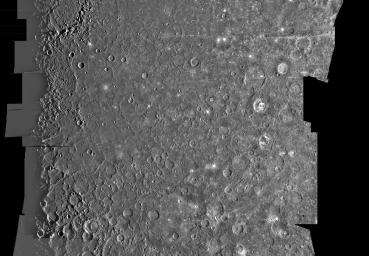
|
Mercury: Photomosaic of the Tolstoj Quadrangle H-8
- Click the image above for a larger view
- Full-Res JPEG (7200 x 5000) (4.3 MB)
- Full-Res TIFF (7200 x 5000) (28.8 MB)
Caption:
This computer generated photomosaic from Mariner 10 is of Mercury's Tolstoj Quadrangle, named for the ancient Tolstoj crater located in the lower center of the image. This quadrangle covers the geographic region from 25 degrees south to 25 degrees north latitude and from 144 to 216 degrees longitude. The photomosaic was produced using computer techniques and software developed in the Image Processing Laboratory of NASA's Jet Propulsion Laboratory. The pictures have been high-pass filtered and contrast enhanced to accentuate surface detail, and geometrically transformed into a Mercator conformal projection.
The extensive areas of smooth surfaces or plains depicted in this mosaic have been classified into three types. The most widespread type forms a level to gently rolling ground between and around large craters and basins, and characterized by an extremely high density of superimposed small craters. A second type, "hummocky" plains, occurs within a broad ring that is 600 to 800 kilometers wide and circumscribes the Caloris Planitia (in the upper left corner of the image). These plains consist of low, closely spaced to scattered hills. "Smooth" plains are the third type and form relatively level tracts with a very low population of craters, both within and external to the basins.
The above material was taken from the following publication... Davies, M. E., S. E. Dwornik, D. E. Gault, and R. G. Strom, Atlas of Mercury , NASA SP-423 (1978).
Background Info:
The Mariner 10 mission was managed by the Jet Propulsion Laboratory for NASA's Office of Space Science.
Cataloging Keywords:
| Name | Value | Additional Values |
|---|---|---|
| Target | Mercury | |
| System | ||
| Target Type | Planet | |
| Mission | Mariner | |
| Instrument Host | Mariner 10 | |
| Host Type | Flyby Spacecraft | |
| Instrument | ||
| Detector | ||
| Extra Keywords | Crater, Grayscale | |
| Acquisition Date | ||
| Release Date | 1996-09-23 | |
| Date in Caption | ||
| Image Credit | NASA/JPL | |
| Source | photojournal.jpl.nasa.gov/catalog/PIA00068 | |
| Identifier | PIA00068 | |
